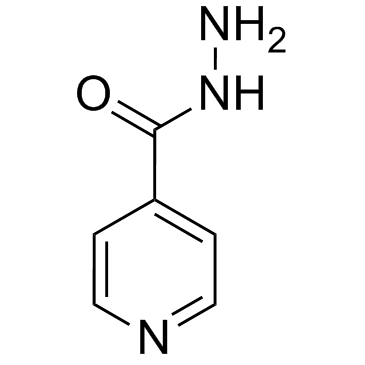| Cas No.: | 54-85-3 |
| Synonyms: | Tubizid, Laniazid, Nydrazid, Isonicotinylhydrazine |
| SMILES: | O=C(NN)C1=CC=NC=C1 |
| Formula: | C6H7N3O |
| M.Wt: | 137.14 |
| Purity: | >99% |
| Sotrage: | 2 years -20°C Powder, 2 weeks 4°C in DMSO, 6 months -80°C in DMSO |
| Publication: | [1]. Suarez, J., et al., An oxyferrous heme/protein-based radical intermediate is catalytically competent in the catalase reaction of Mycobacterium tuberculosis catalase-peroxidase (KatG). J Biol Chem, 2009. 284(11): p. 7017-29. [2]. Timmins, G.S., et al., Nitric oxide generated from isoniazid activation by KatG: source of nitric oxide and activity against Mycobacterium tuberculosis. Antimicrob Agents Chemother, 2004. 48(8): p. 3006-9. [3]. Singh, R., et al., PA-824 kills nonreplicating Mycobacterium tuberculosis by intracellular NO release. Science, 2008. 322(5906): p. 1392-5. [4]. Ahmad, Z., et al., Biphasic kill curve of isoniazid reveals the presence of drug-tolerant, not drug-resistant, Mycobacterium tuberculosis in the guinea pig. J Infect Dis, 2009. 200(7): p. 1136-43. |
| Description: | Isoniazid is an antibacterial agent used primarily as a tuberculostatic.Target: AntibacterialIsoniazid is a prodrug and must be activated by a bacterial catalase-peroxidase enzyme that in M. tuberculosis is called KatG [1]. KatG couples the isonicotinic acyl with NADH to form isonicotinic acyl-NADH complex. This complex binds tightly to the enoyl-acyl carrier protein reductase known as InhA, thereby blocking the natural enoyl-AcpM substrate and the action of fatty acid synthase. This process inhibits the synthesis of mycolic acid, required for the mycobacterial cell wall. A range of radicals are produced by KatG activation of isoniazid, including nitric oxide, which has also been shown to be important in the action of another antimycobacterial prodrug PA-824 [2, 3]. Isoniazid is bactericidal to rapidly dividing mycobacteria, but is bacteriostatic if the mycobacteria are slow-growing [4]. |
| References: | [1]. Suarez, J., et al., An oxyferrous heme/protein-based radical intermediate is catalytically competent in the catalase reaction of Mycobacterium tuberculosis catalase-peroxidase (KatG). J Biol Chem, 2009. 284(11): p. 7017-29. [2]. Timmins, G.S., et al., Nitric oxide generated from isoniazid activation by KatG: source of nitric oxide and activity against Mycobacterium tuberculosis. Antimicrob Agents Chemother, 2004. 48(8): p. 3006-9. [3]. Singh, R., et al., PA-824 kills nonreplicating Mycobacterium tuberculosis by intracellular NO release. Science, 2008. 322(5906): p. 1392-5. [4]. Ahmad, Z., et al., Biphasic kill curve of isoniazid reveals the presence of drug-tolerant, not drug-resistant, Mycobacterium tuberculosis in the guinea pig. J Infect Dis, 2009. 200(7): p. 1136-43. |

 DC Chemicals' products qualify for U.S. tariff exemptions. We guarantee no price increases due to customs duties and maintain stable supply, continuing to deliver reliable research solutions to our American clients.
DC Chemicals' products qualify for U.S. tariff exemptions. We guarantee no price increases due to customs duties and maintain stable supply, continuing to deliver reliable research solutions to our American clients.





















